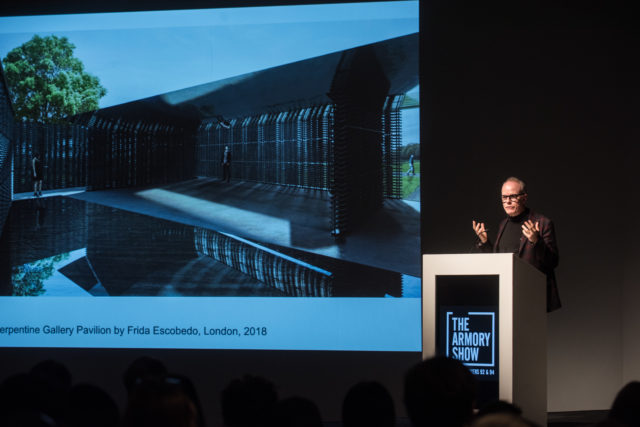
Hans Ulrich Obrist delivering his keynote at The Armory Show
The line for last week’s keynote lecture at the Armory Show was as long as the speaker’s resume; slated to talk was Hans Ulrich Obrist, artistic director of the Serpentine Gallery and arguably the most famous curator in the world. But since Obrist is a fixture at large art fairs, the huge turnout was a surprise. Having watched a few of his interviews online, I worried that the talk would be a pretentious ramble. My fears weren’t entirely unfounded, though no one could accuse Obrist of lacking enthusiasm as he spent well over an hour discussing notions of time, the archive, unrealized projects, and the Serpentine’s recent shows. Central to all of this was his belief in the freedom to experiment.
But Obrist’s talk had limited success in getting attendees fired up, likely because of the curator’s consistent failure to fully elucidate his themes. For example, he described Jean-François Lyotard’s 1985 exhibition Les Immatériaux at the Pompidou as exciting because it happened before the internet was invented, while neglecting to mention its central thesis about how “immaterials” (technology) alters our relationship to materials. An unrealized project by Lyotard, which Obrist said he’d be working on with Moderna Museet Director Daniel Birnbaum, would explore “the underside of communication” and would be “about noise, about distortion, about the dimension of experience, about frictions,” But no further detail was forthcoming.
But at least Obrist managed, in Lyotard’s case, to give the curator’s full name. Discussing the idea that government bodies should run artists’ residencies, the curator cited a project by two artists he referred to only as “Barbara and John.” As he told it, some time during the 1960s, the pair took up residency in Scotland’s parliament and convinced politicians not to clean up five toxic mountains of coal waste, instead suggesting they recategorize them sculptural meditations on the importance of renewable energy. “The world would be a different world!,” Obrist concluded to puzzled looks. (I later discovered that the project was Five Sisters by John Latham and Barbara Steveni, artists associated with the Artist Placement Group.)
While Obrist’s excitement, then, sometimes led to sloppy presentation, he also tended to aggrandize simple thoughts and actions, describing, for example, the thousands of interviews he’s conducted as “a process against forgetting.” He replaced the term “curator,” which he found limiting, with “juncture,” a word lent undue importance because novelist J.G. Ballard had once told him he preferred it. And later in the talk he praised the Serpentine Gallery for appointing a chief technology officer, as if this were a novel idea.
But while all of this was annoying, Obrist’s interest in making creative use of simple John Cage-like parameters still serves him well. In 2007, for example, Obrist and a team of other curators invited artists to contribute to a multi-authored opera called Il Tempo del Postino for the Manchester International Festival. Each artist was given 15 minutes to produce a time-based art work that would be showcased on stage. In another series, he used the framework of a 24 hour marathon, to create an event that focuses on a different activity each year be it interviews, experimentation, manifestos. In both cases, these parameters created accessible events that brought in huge audiences.
What Obrist didn’t discuss was the success of Do It, an exhibition conceived in 1993 as a prompt in which 12 artists were asked to writes instructions for artworks that other individuals and institutions could produce and exhibit. The project has since been made into a book and circulated internationally. In fact, it’s so popular, the exhibition might as well be a meme. In addition to its online version, created by Obrist in collaboration with e-flux in 2004, other iterations include do it (museum), do it (home), do it (TV), do it (seminar), do it (outside), do it (party), as well as some anti-do its, a philosophy do it and a UNESCO children’s do it. Last year, the exhibition made headlines once more when Independent Curators International (ICI), in collaboration with Studio in a School, announced that Do It would become part of New York’s high school art curriculum.
Given its potential impact on his audience at the Armory, this was a major omission. But for all Obrist’s excitement about making connections and experimentation, it seems conversation was a bit lower down the curator’s list of values. Obrist didn’t take questions after the talk, and when asked about the program afterwards, he snipped dismissively, “It’s already in the schools. You can find it online. ICI has all the information.” I followed his instructions only to learn that the program would be implemented this fall, and would impact about three hundred students. In the Spring of 2019, these participants will present their work at Hunter College’s East Harlem Gallery. The project has the potential to be a big deal, then, for a few New Yorkers, but I’m not sure we’ll see its originator at the opening.


Comments on this entry are closed.